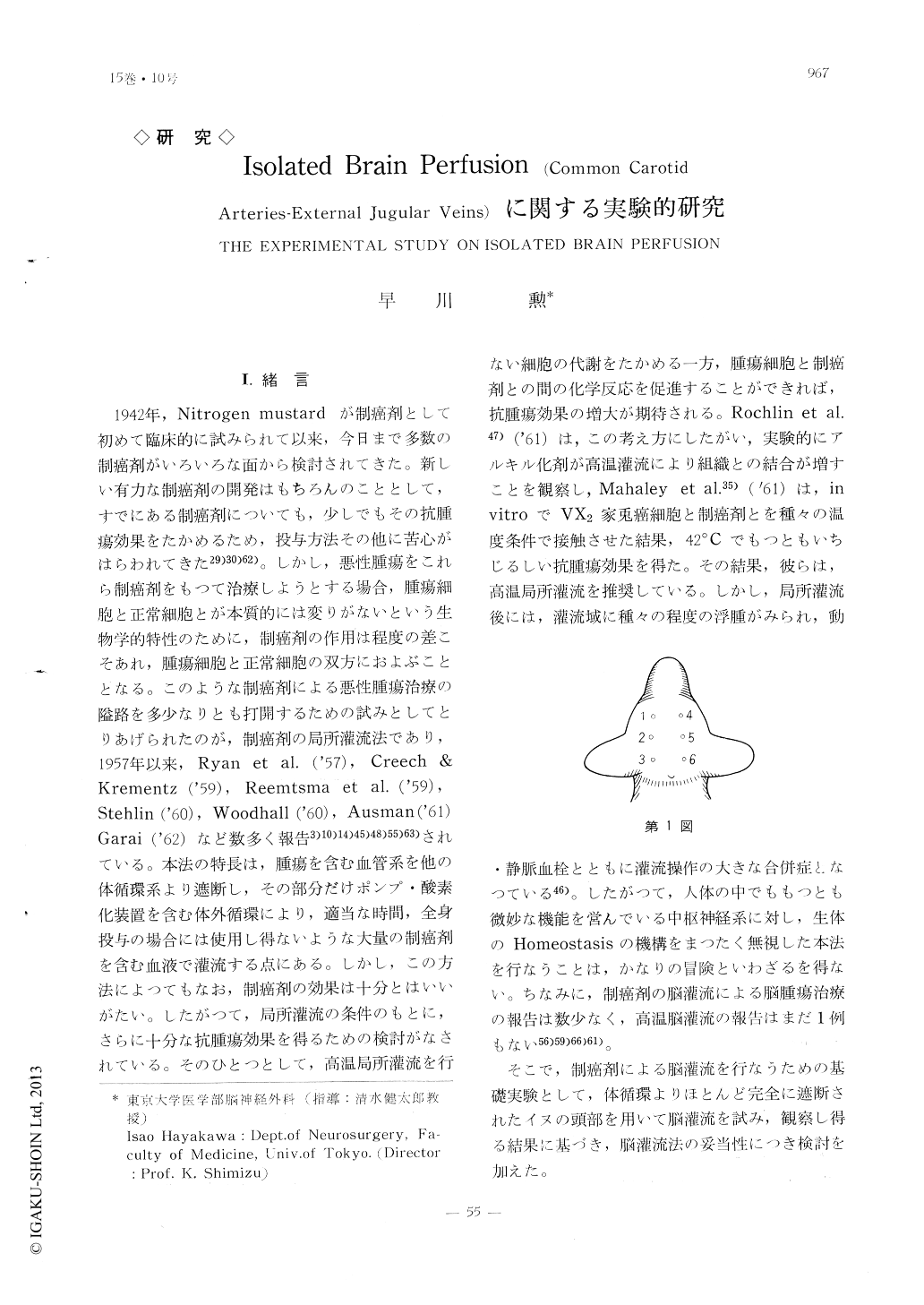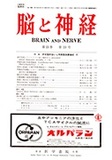Japanese
English
- 有料閲覧
- Abstract 文献概要
- 1ページ目 Look Inside
I.緒言
1942年,Nitrogen mustardが制癌剤として初めて臨床的に試みられて以来,今日まで多数の制癌剤がいろいろな面から検討されてきた。新しい有力な制癌剤の開発はもちろんのこととして,すでにある制癌剤についても,少しでもその抗腫瘍効果をたかめるため,投与方法その他に苦心がはらわれてきた29)30)62)。しかし,悪性腫瘍をこれら制癌剤をもつて治療しようとする場合,腫瘍細胞と正常細胞とが本質的には変りがないという生物学的特性のために,制癌剤の作用は程度の差こそあれ,腫瘍細胞と正常細胞の双方におよぶこととなる。このような制癌剤による悪性腫瘍治療の隘路を多少なりとも打開するための試みとしてとりあげられたのが,制癌剤の局所灌流法であり,1957年以来,Ryan et al.('57), Creech & Krementz ('59), Reemtsma et al. ('59), Stehlin ('60), Woodhall ('60), Ausman ('61) Garai ('62)など数多く報告3)10)14)45)48)55)63)されている。本法の特長は,腫瘍を含む血管系を他の体循環系より遮断し,その部分だけポンプ・酸素化装置を含む体外循環により,適当な時間,全身投与の場合には使用し得ないような大量の制癌剤を含む血液で灌流する点にある。しかし,この方法によつてもなお,制癌剤の効果は十分とはいいがたい。したがつて,局所灌流の条件のもとに,さらに十分な抗腫瘍効果を得るための検討がなされている。そのひとつとして,高温局所灌流を行ない細胞の代謝をたかめる一方,腫瘍細胞と制癌剤との間の化学反応を促進することができれば,抗腫瘍効果の増大が期待される。Rochlin et al.47)('61)は,この考え方にしたがい,実験的にアルキル化剤が高温灌流により組織との結合が増すことを観察し,Mahaley et al.35)('61)は,in vitroでVX2家兎癌細胞と制癌剤とを種々の温度条件で接触させた結果,42℃でもつともいちじるしい抗腫瘍効果を得た。その結果,彼らは,高温局所灌流を推奨している。しかし,局所灌流後には,灌流域に種々の程度の浮腫がみられ,動・静脈血栓とともに灌流操作の大きな合併症となつている46)。したがつて,人体の中でももつとも微妙な機能を営んでいる中枢神経系に対し,生体のHomeostasisの機構をまつたく無視した本法を行なうことは,かなりの冒険といわざるを得ない。ちなみに,制癌剤の脳灌流による脳腫瘍治療の報告は数少なく,高温脳灌流の報告はまだ1例もない56)59)66)61)。
そこで,制癌剤による脳灌流を行なうための基礎実験として,体循環よりほとんど完全に遮断されたイヌの頭部を用いて脳灌流を試み,観察し得る結果に基づき,脳灌流法の妥当性につき検討を加えた。
1) Isolated brain perfusion (common carotid arteries-external jugular veins) using an ext-racorporeal pump-oxygenator was studied in adult dogs under light nembutal anesthesia. Leakage of Evans blue from the perfused area to the systemic circulation under this conditon was a few per cent in 60 min of perfusion period.
2) Venous return in the circuit decreased gradually as a time of perfusion period pas-sed, and fell to 57% of the start level in 60 min. of perfusion period. Coincident with this, exophthalmos became perceptive.
3) Injection of hypertonic urea into the arterial side of the extracorporeal circuit imp-roved markedly the venous return in all cases, average increase being 129.9% in the venous return within 30 min. after injection and its effect continuing for about 21.8 min.
4) Sugar level of the perfused blood sam-pled in the venous side of the extracorporeal circuit dropped by about 10 mg/dl in 60 min. of perfusion period.
5) By perfusing the brain with blood war-med in water-bath of 45-48℃. it was possi-ble to achieve brain temperature of 43.3℃ in 15-25 min. of perfusion.
6) No significant electroencephalographic changes were observed in flow rates of 2-5 cc/kg/min. in 60 min. of normothermic perfu-sion.
7) In hyperthermic brain perfusion, the brain temperature of 33℃-39.9℃ did not give any significant electroencephalographic chan-ges in 60 min. of perfusion; at the brain tem-perature of 40℃-40.9℃, slowing and amplitu-de decrease of EEG were noted in 30 min. of perfusion, and at the brain temperature of 43.3℃, flattening of EEG occured in 45 min. of perfusion.
8) Elevation of the systemic blood pres-sure was observed in all cases, and this hy-pertensive state continued for all period of isolated brain perfusion as long as the heart was functioning.
9) It was concluded that the isolated brain perfusion should be limited to the period of 60 min. in optimal flow rates from the stand point of the EEG and the venous return, and that the perfusion pressure as well as the perfusion flow rates shoued be maintained in a certain level, and in hyperthermic brain perfusion, brain temperature of 40℃ for 60 min. shold be the maximal limit.

Copyright © 1963, Igaku-Shoin Ltd. All rights reserved.


